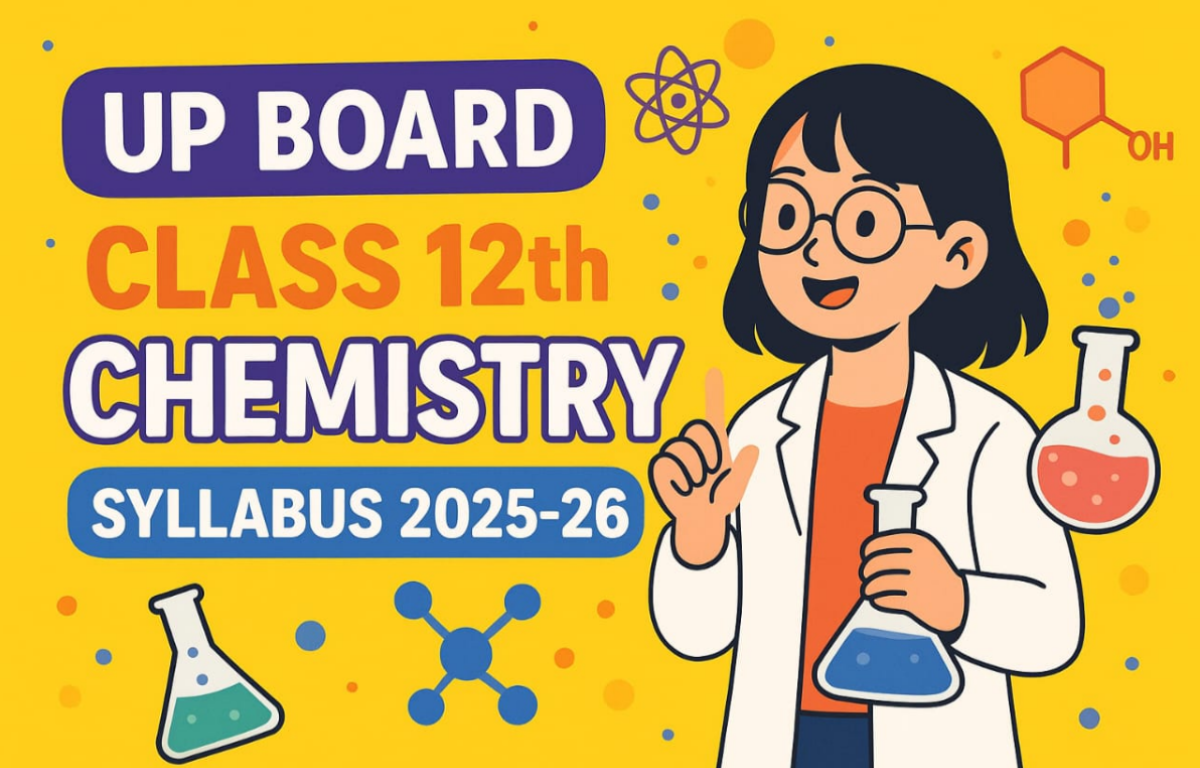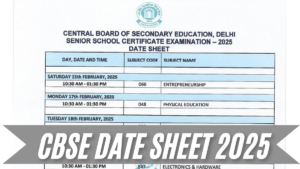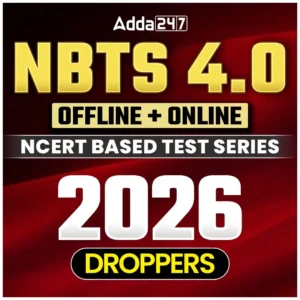UP Board Class 12 Chemistry Syllabus 2025-26: The Uttar Pradesh Madhyamik Shiksha Parishad (UPMSP) has recently released the updated Class 12th syllabus for Chemistry on its official portal. The syllabus has been released in online PDF form, so students are not required to enter any login credentials to access it. The syllabus includes all important topics from Physical, Organic, and Inorganic chemistry, ensuring students focus on the right areas for board exams. To check and download the online UP Board class 12th Chemistry syllabus for the academic year 2025-26, students can either visit the official website https://upmsp.edu.in/ or access the syllabus by clicking on the direct link shared in the article below and going through the detailed topics before starting their final exam preparation.
UP Board Class 12 Chemistry Syllabus 2025-26
For the science students, the UP Board Class 12 Chemistry exam is one of the most crucial papers since it is not only about the board mark but also competitive exams. The exam usually comprises short-answer questions, long-answer questions, and numerical-based questions, all with a range of topics in organic, inorganic, and physical chemistry. Students should focus on NCERT-based meaning, chemical reactions, equations, and the ability to solve problems on their own.
The UP Board Class 12 syllabus has been updated, so it is important to refer to the most updated syllabus since it outlines what a student is required to prepare for without all the confusion. In addition to the syllabus, students can rely on previous year question papers, model papers, and sample test papers to practice effectively. It is wise to consistently revise and do practice papers, as this will develop confidence, which enables the student to successfully manage their time in the final exam.
Class 12th Unit-Wise Chemistry Syllabus for UP Board
The UP Board Class 12th Chemistry Syllabus consists of 10 different units. Students can check the unit-wise chemistry syllabus for the academic session 2025-26 below:
- Solutions
- Electrochemistry
- Chemical Kinetics
- d -and f -Block Elements
- Coordination Compounds
- Haloalkanes and Haloarenes
- Alcohols, Phenols, and Ethers
- Aldehydes, Ketones, and Carboxylic Acids
- Amines
- Biomolecules
UPMSP Class 12 Detailed Chemistry Syllabus
The UP Board Class 12 Chemistry (code 152) syllabus is very important for students preparing for their board exams. It covers topics like physical chemistry, organic chemistry, and inorganic chemistry, which help in building strong concepts for both exams and competitive tests. With the updated syllabus released by UPMSP, students can now plan their studies in a smarter way. Knowing the detailed syllabus helps in understanding weightage and important chapters. Students can check the UP Board Class 12 Chemistry detailed syllabus below.
Unit 1: Solutions
Types of solutions, expression of concentration of solutions of solids in liquids, solubility of gases in liquids, solid solutions, Raoult’s law, colligative properties – relative lowering of vapor pressure, elevation of boiling point, depression of freezing point, osmotic pressure, determination of molecular masses using colligative properties, abnormal molecular mass, Van’t Hoff factor
Unit 2: Electrochemistry
Redox reactions, EMF of a cell, standard electrode potential, Nernst equation and its application to chemical cells, Relation between Gibbs energy change and EMF of a cell, conductance in electrolytic solutions, specific and molar conductivity, variations of conductivity with concentration, Kohlrausch’s Law, electrolysis and law of electrolysis (elementary idea), dry cell-electrolytic cells and Galvanic cells, lead accumulator, fuel cells, corrosion.
Unit 3: Chemical Kinetics
Rate of a reaction (Average and instantaneous), factors affecting rate of reaction: concentration, temperature, catalyst; order and molecularity of a reaction, rate law and specific rate constant, integrated rate equations and half-life (only for zero and first order 10 reactions), concept of collision theory (elementary idea, no mathematical treatment), activation energy, Arrhenius equation.
Unit 4: d and f Block Elements
General introduction, electronic configuration, occurrence and characteristics of transition metals, general trends in properties of the first row transition metals – metallic character, ionization enthalpy, oxidation states, ionic radii, colour, catalytic property, magnetic properties, interstitial compounds, alloy formation, preparation and properties of K2Cr2O7 and KMnO4.
- Lanthanides – Electronic configuration, oxidation states, chemical reactivity, and lanthanide contraction and its consequences.
- Actinides – Electronic configuration, oxidation states, and comparison with lanthanides
Unit 5: Coordination Compounds
Coordination compounds – Introduction, ligands, coordination number, colour, magnetic properties and shapes, IUPAC nomenclature of mononuclear coordination compounds. Bonding, Werner’s theory, VBT, and CFT; structure and stereoisomerism, importance of coordination compounds (in qualitative analysis, extraction of metals, and biological systems).
Unit 6: Haloalkanes and Haloarenes
- Haloalkanes: Nomenclature, nature of C–X bond, physical and chemical properties, optical rotation, mechanism of substitution reactions.
- Haloarenes: Nature of C–X bond, substitution reactions (Directive influence of halogen in monosubstituted compounds only). Uses and environmental effects of – dichloromethane, trichloromethane, tetrachloromethane, iodoform, freons, DDT.
Unit 7: Alcohols, Phenols, and Ethers
- Alcohols: Nomenclature, methods of preparation, physical and chemical properties (of primary alcohols only), identification of primary, secondary, and tertiary alcohols, mechanism of dehydration, uses with special reference to methanol and ethanol.
- Phenols: Nomenclature, methods of preparation, physical and chemical properties, acidic nature of phenol, electrophilic substitution reactions, uses of phenols.
- Ethers: Nomenclature, methods of preparation, physical and chemical properties, uses
Unit 8: Aldehydes, Ketones, and Carboxylic Acids
- Aldehydes and Ketones: Nomenclature, nature of carbonyl group, methods of preparation, physical and chemical properties, mechanism of nucleophilic addition, reactivity of alpha hydrogen in aldehydes, uses.
- Carboxylic Acids: Nomenclature, acidic nature, methods of preparation, physical and chemical properties; uses.
Unit 9: Amines
- Amines: Nomenclature, classification, structure, methods of preparation, physical and chemical properties, uses, and identification of primary, secondary, and tertiary amines.
- Diazonium salts: Preparation, chemical reactions, and importance in synthetic organic chemistry.
Unit 10: Biomolecules
- Carbohydrates: Classification (aldoses and ketoses), monosaccharides (glucose and fructose), D-L configuration oligosaccharides (sucrose, lactose, maltose), polysaccharides (starch, cellulose, glycogen); Importance of carbohydrates.
- Proteins: Elementary idea of – amino acids, peptide bond, polypeptides, proteins, structure of proteins – primary, secondary, tertiary structure and quaternary structures (qualitative idea only), denaturation of proteins; enzymes.
- Hormones: Elementary idea excluding structure.
- Vitamins: Classification and functions.
- Nucleic Acids: DNA and RNA.
UP Board Class 12th Chemistry Syllabus 2025-26 PDF Download Link
The official link to check and download the online UP Board Class 12th Chemistry Syllabus for the academic year 2025-26 has been activated at the official website of Uttar Pradesh Madhyamik Shiksha Parishad (UPMSP) https://upmsp.edu.in/. Understanding the latest syllabus helps students to get a better idea of which topics are important, along with the updated exam pattern, chapter-wise weightage, and many other things that the student needs to know before the final board exams. To provide easy access to the syllabus, students can also check the direct link below:
UP Board Class 12 Chemistry Unit-Wise Weightage
UP Board Class 12 Chemistry exam preparation becomes easier when students know the unit-wise weightage. It helps them focus on the most important chapters for both theory and practical exams. With proper knowledge of mark distribution, students can plan smartly, revise effectively, and score higher in board exams. Below, you can check the detailed unit-wise weightage for Chemistry theory and practical papers, which will guide you in your preparation journey.
UP Board Class 12 Unit-Wise Marks Distribution
| UP Board Class 12 Unit-Wise Marks Distribution | ||
| Unit Number | Unit Name | Weightage |
| Unit 1 | Solutions | 07 |
| Unit 2 | Electrochemistry | 09 |
| Unit 3 | Chemical Kinetics | 07 |
| Unit 4 | d -and f -Block Elements | 07 |
| Unit 5 | Coordination Compounds | 07 |
| Unit 6 | Haloalkanes and Haloarenes | 06 |
| Unit 7 | Alcohols, Phenols, and Ethers | 06 |
| Unit 8 | Aldehydes, Ketones, and Carboxylic Acids | 08 |
| Unit 9 | Amines | 06 |
| Unit 10 | Biomolecules | 07 |
| Total Marks | 70 Marks | |
Practical Exam Marking Scheme for Class 12 Chemistry
Practical Exam: External Evaluation
| External Evaluation (15 Marks) | |
| Components | Marks |
| Qualitative Analysis (Simple Salt) | 04 |
| Volumetric Analysis (Simple Titration) | 04 |
| Subject-Based Experiment | 03 |
| Viva Voce | 04 |
| Total Marks | 15 |
Practical Exam: Internal Evaluation
| Practical Exam: Internal Evaluation | |
| Components | Marks |
| Project and Viva | 08 |
| Class Record | 04 |
| Subject-Based Experiment | 03 |
| Total Marks | 15 |
UP Board Class 12 Chemistry Preparation Plan
Here we have provided a student-friendly preparation plan for the upcoming UP Board Class 12 Chemistry exam that balances theory, numericals, and revision in a smart way:
Step 1: Know the Syllabus & Exam Pattern
- Total Marks: 100 (70 theory + 30 practical)
- Theory Paper: Mostly NCERT-based, with direct & conceptual questions.
- Sections: Organic, Inorganic, and Physical Chemistry.
- Priority chapters (as per weightage in UP Board & NCERT alignment):
| Important Chapters for Chemistry | |
| Physical Chemistry | Electrochemistry, Chemical Kinetics, Solutions, Solid State |
| Inorganic Chemistry | Coordination Compounds, d-block, p-block (Group 15 & 16 important) |
| Organic Chemistry | Aldehydes, Ketones, Amines, Haloalkanes, Alcohols, Biomolecules |
Step 2: Study Strategy (Subject-Wise)
- Physical Chemistry
- Revise formulas and derivations from NCERT.
- Practice numericals daily (at least 10 per day).
- Solve previous years’ questions – many are repeated.
- Inorganic Chemistry
- Focus on the NCERT lines; most questions come directly.
- Make short notes of reactions, exceptions, and trends.
- Revise coordination compound naming & VBT/CFSE concepts multiple times.
- Organic Chemistry
- Write down named reactions in a separate notebook.
- Practice mechanisms & conversions step by step.
- Revise IUPAC naming & functional group reactions thoroughly.
Step 3: Daily Timetable (3–4 Hours for Chemistry)
- Morning (Fresh Mind):
- 1 hr Physical Chemistry (numericals + concepts)
- Afternoon/Evening:
- 1 hr Organic Chemistry (reactions + practice conversions)
- 1 hr Inorganic Chemistry (NCERT reading + reaction revision)
- Before Sleeping:
- Quick 20–30 mins flashcards/short notes revision.
Step 4: Practice & Revision
- NCERT can become your best study guide – read each chapter line by line.
- Solve the last 10 years’ UP Board Question papers for a better understanding of the exam pattern and the types of questions asked.
- Attempt sample papers & mock tests under a time limit.
- Revise important diagrams – electrolytic cell, structures of compounds, etc.
- For practical exam: Revise salt analysis, titration, and tests of functional groups.
Step 5: 1-Month Smart Revision Plan
- Week 1–2: Complete syllabus revision (chapter-wise).
- Week 3: Focus on high-weightage topics + PYQs.
- Week 4: Quick revision from notes + full-length mock tests.










 UPMSP Center List 2026 Released, Check D...
UPMSP Center List 2026 Released, Check D...
 UP Board Class 12 Syllabus 2025-26 Out, ...
UP Board Class 12 Syllabus 2025-26 Out, ...
 CBSE Date Sheet 2025 Out, Download Class...
CBSE Date Sheet 2025 Out, Download Class...













